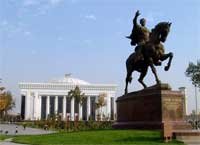April 2, 2014
Socially Important Projects Receive Support. 2
Tashkent hosts Uzbekistan-Singapore Business Forum and Cooperation Exchange. 3
Tashkent Airport included to Top-10 of the best airports in Russia and CIS. 3
New Riddle of the Ancient Khiva.. 4
Press-service of MFA of the Republic of Uzbekistan
Society
Socially Important Projects Receive Support
Priorities of the Public Fund for the Support of NGOs and other Civil Society Institutions under Oliy Majlis of the Republic of Uzbekistan for 2014 have been discussed at a press conference in the lower house of parliament.
The purpose of the meeting was to inform the public about the priorities for the provision of financial support to civil society institutions this year, state support for initiatives of NGOs and the media, their active participation in the development and implementation of the most important projects in national, regional socio-economic development, addressing humanitarian challenges, defending democratic values, human rights, freedoms and legitimate interests of the population.
In order to achieve the objectives, the Parliamentary Committee on Public Funds Management under Oliy Majlis of the Republic of Uzbekistan has allocated over UZS37 billion from 2008 to 2014 in the form of state subsidies, grants and social orders. Targeted and effective provision of government support ensures comprehensive and systematic approach to the organization of interaction of the Parliamentary Commission with NGOs and other civil society institutions.
The press conference emphasized that the measures taken in the framework of the phased implementation of the Concept of Further Deepening Democratic Reforms and Formation of Civil Society in the Country is becoming an important factor in strengthening practical social partnership of institutions of civil society, including NGOs and the media, with government agencies, favors the establishment of effective feedback between the public and the state.
For the implementation of priority activities of NGOs and other civil society institutions aimed at increasing their activity in 2014, the Parliamentary Commission allocated funds amounting to UZS8.2 billion, which is 17.1% as much as those in 2013. More than UZS3.8 billion or 46.3% of the total funds are allocated for grant competitions and project financing in the form of government grants aimed at organizing and conducting competitions for healthy generation with great future, promoting involvement of NGOs for implementation of the crucial tasks of the national program “The Year of Healthy Child”.
The contest to promote a healthy lifestyle is planned, instilling love of the young generation to physical culture and sport, development of creative and intellectual potential of young people, especially in regions. A particular attention is paid to competitions aimed at the development of social partnership between civil society and state agencies in the implementation of socio-economic development of regions, improving the welfare of the population, business development and assistance to socially vulnerable groups of the population.
A separate area of the competition is designed to support independent media projects aimed at lighting process of deepening democratic reforms and formation of civil society, promotion of healthy lifestyles, especially among young people, improving the legal culture and justice.
Thus, the total amount of the five areas of grant competitions is 67 socially important topics. Growth in funds allocated for grant competitions was 15.8% compared to the last year.
A resolution of the Parliamentary Commission announced a competition for occupancy of the social order of NGOs and other civil society institutions to implement projects aimed at addressing specific social issues, which are of great public importance. Emphasized that while aid placement social orders of NGOs, the media and other civil society institutions increased by 6.0% compared to last year.
“So, in 2014, for social order among NGOs and other civil society institutions allocated UZS1.4 billion or 17.0% of total funds,” said Senator Damir Siddikov, deputy chair of the parliamentary committee for management of the assets of the Public Fund for Support NGOs and other Civil Society Institutions. “In this connection provides for the implementation of tasks aimed at implementing measures to further develop and ensure the active participation of the third sector in the creation of conditions for the formation of healthy, harmonious development of children, as well as strengthening foundations of family.”
In order to ensure transparency, openness of ongoing socio-political, socio-economic reforms there are provisions for systematic organization of advocacy about the nature and significance of the national program, measures implemented to ensure support to the younger generation.
(Source: “Uzbekistan Today” newspaper)
INTERNATIONAL COOPERATION
Tashkent hosts Uzbekistan-Singapore Business Forum and Cooperation Exchange
Tashkent hosts Uzbekistan-Singapore Business Forum and Cooperation Exchange – Uzbekistan News The Uzbekistan-Singapore Business Forum and Cooperation Exchange were held yesterday within the visit to Uzbekistan of Singaporean business delegation which was attended by representatives of the business circles of the two countries.
During the event, participants discussed issues of further deepening of economic cooperation between Uzbekistan and Singapore. Singaporean delegation got acquainted with the investment climate created in Uzbekistan, including in Navoi and Angren FIEZs.
The participants discussed trade cooperation prospects, promising investment projects in electrical and leather-footwear industry, building materials manufacture, and development of energy infrastructure, including alternative energy sources. The Forum participants got acquainted with the economy and the business climate in Singapore.
Tashkent hosts Uzbekistan-Singapore Business Forum and Cooperation Exchange – Uzbekistan News The Forum has become a logical continuation of cooperation in trade, economic and investment areas between the two countries. Uzbekistan and Singapore attach great importance to developing comprehensive mutually beneficial cooperation. The state visit of President Islam Karimov to Singapore in January 2007 has given significant impetus to bilateral relations. Currently there are 33 Uzbek-Singaporean joint ventures operating in Uzbekistan, including 7 wholly foreign owned enterprises. We hope that today’s meetings will further strengthen the foundation of our business relations and reveal to us new ways to expand cooperation,- said the Deputy Director General of UzInfoInvest Abdurahimov Jamshid.
A number of intergovernmental and interagency agreements were signed between Uzbekistan and Singapore, including “On air services”, “On Promotion and Reciprocal Protection of Investments”, “On main directions of economic and humanitarian cooperation”, “Avoidance of Double Taxation and suppression of tax evasion on income” and cooperation agreements between MFERIT and the Ministry of Trade and Industry of Singapore, as well as several others.
Tashkent hosts Uzbekistan-Singapore Business Forum and Cooperation Exchange – Uzbekistan News The volume of trade turnover between the two countries in 2013 amounted to 47.6 million dollars.
Uzbek-Singaporean Cooperation Exchange was held after the Forum which was attended by the businesses of the two countries. Entrepreneurs and investors discussed in a friendly atmosphere the most interesting and promising projects in such areas as alternative energy, engineering and services sector, in particular, marketing, consulting and others. The participants expressed the hope that fruitful negotiations will soon result in the signing of new contracts and agreements.
(Source: Uzreport.uz)
INFRASTRUCTURE
Tashkent Airport included to Top-10 of the best airports in Russia and CIS
International Airport “Tashkent” has been included to the Top-10 of the best airports of Russia and CIS in line with the version of British company Skytrax.
International Airport “Tashkent” claimed the ninth place in Top-10. It was behind Russian airports Domodedovo, Sheremetovo, Kazan and Vnukovo, Kazakh airports Astana and Almaty, Belarusian airport Minsk and airport named after Heydar Aliev in Baku (Azerbaijan).
Private British consulting company Skytrax specializes in studying quality of services, provided by airlines and airports worldwide.
Skytrax World Airport Awards is awarded following the results of surveys conducted at the airports which allows to objectively evaluate the quality of the services provided. Respondents express their opinion on the entire range of services rendered by an air hub: the survey covers 39 parameters.
This year’s survey involving over 12 million people was held at 410 airports worldwide.
(Source: Uzdaily.com)
HISTORY
New Riddle of the Ancient Khiva
Back in 2009 during excavation five kilometers north-west of the city of Khiva, closer to the Yangiobod suburbs, archeologists discovered site Ahunlar. According to local residents, one can meet various archaeological artifacts there, including pottery, burnt bricks and coins.
In 2010, as a result of the preliminary work on the grant “The history of the material culture of medieval towns of Southern Khorezm’ under Mamun Academy, scientists have found that the area of distribution of archaeological material covers about 20 hectares of land on both sides of a wide ditch, having a more recent origin. Along it were traces of cultural layers, covered with sand. In some places the walls could be seen to have been made of pakhsa. After cleaning, archeologists opened a part of construction. Its southern part were razed, and the walls were 1.3 meter thick. In the east wall there are small arched alcoves arranged in three rows.
On the western bank of the ditch archeologists found remains of a second facility with square-shaped room form with thick walls up to 0.6 meters and two aisles inside. The interior consisted of two Sufas, ceramic and clay hearths. First sufa occupies almost the entire northern half of the room, the second was located in the south-east corner.
On the south side there is a corridor with a large alcove with a raised floor. In the mid there is a septum of later origin made of pakhsa and guvala. In the pit of unknown purpose, archeologists found ceramic pieces and an iron sickle.
The excavations have collected a significant amount of pottery, which was around the hearth and in the pit. Hearth itself was egg-shaped and made of good clay elutriated with smooth firing, coated with adobe clay, covered with various vessel pieces: grey pottery jug, a large bowl, glazed bowl, also covered with clay. Perhaps some time it has been used as a tandoor. Similar hearths were found on the Kyat-kala site in Shovot district.
The monument, according to ceramic materials from the excavation refers to the 11-13 centuries. Possibly, during the time of the Golden Horde, it was reconstructed, as evidenced by the separation of the corridor and different finishing materials.
Most likely, it was a country house or manor house with a well-designed plan, with rich household premises belonging to Khorazm Shah period. Scientists have repeatedly expressed the idea that honeycomb-shaped facilities were guestrooms, and the shelves, popularly known as pigeon houses (kaptarkhana) were used to store expensive dishes.
The study of similar structures in other regions enabled the researchers to assume that these unusual houses were used for drying fruits. This idea is based on fruit pits and special bottomless vessels found there during excavations. However, without further work it’s impossible to prove any of the versions.
Thus, according to archaeological evidence and written sources, in the medieval period the suburbs of large cities in Khorazm regions, including Khiva, were densely populated, as evidenced by the discovered settlement Ahunlar.
(Source: “Uzbekistan Today” newspaper)





















